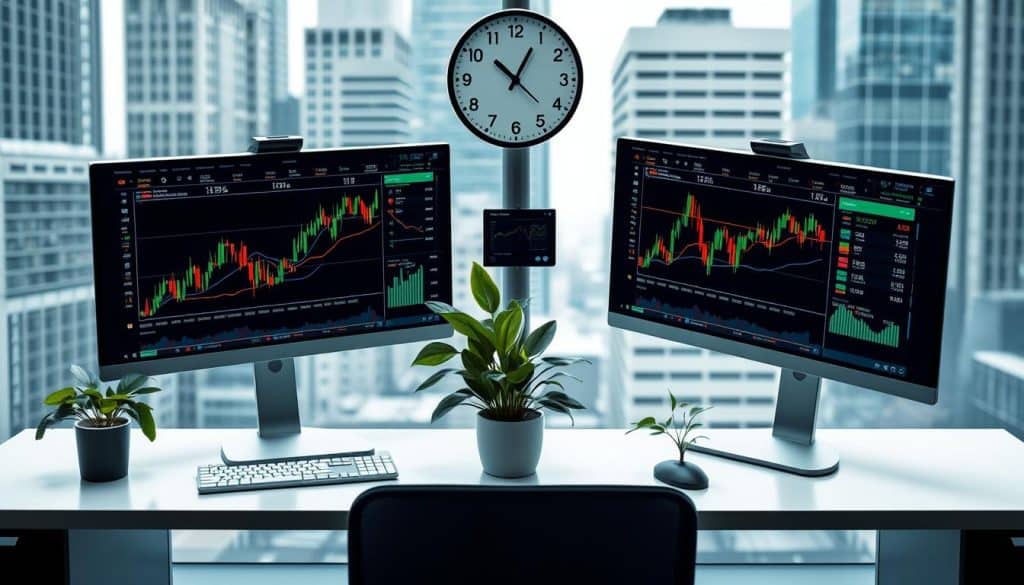Did you know over 75% of traders say success comes from risk management, not just beating the market? The real key to winning in trading is avoiding big losses and keeping your money safe1. This article looks at how crucial managing risk is in trading. It covers the tactics and strategies experienced traders use to stay steady when the market is unpredictable2.
When you’re figuring out what risks to take, there’s the one-percent rule. It says not to risk more than 1% of your trading cash on a single trade1. This isn’t just a theory—it’s a method used by smart investors. They focus on making money over time, not just once3. Using this rule with smart risk management moves, like stop-loss and take-profit orders, helps avoid big losses1.
Diversifying your investments is another key strategy. It means spreading your money across different industries, markets, and places. This balances your risk and makes your portfolio stronger3. It’s a smart way to protect yourself if some investments do poorly. This keeps your financial goals on track, even when the market shakes up3.
Key Takeaways
- Effective trading risk control is crucial for long-term success in volatile markets.
- Adopting the one-percent rule mitigates risk exposure in individual trades.
- Stop-loss and take-profit orders are essential tools for profitable trading.
- Diversifying your portfolio can balance risks and improve overall stability.
- Understanding and employing these strategies can greatly enhance your trading results.
The Essence of Risk Management
Knowing how to manage risks is key to keep your investments safe. This method helps spot and reduce possible trading dangers. Your money stays safer this way.
Preserving Capital
Keeping your capital safe is crucial for successful trading. Using standard deviation helps understand the risk of investments straying from expected results4. It tells us how likely returns are to be close to the average.
For example, returns should be within one standard deviation 67% of the time. They should be within two standard deviations 95% of the time4. It’s also important to only risk 1 to 3 percent of your account on each trade. This keeps losses small and manageable5.
Proactive Measures
Taking steps ahead of time reduces trading risks. Aiming for a risk-to-reward ratio of 1:3 or 1:2 keeps you profitable. Even when less than half your trades win5, setting loss limits also helps.
Big companies have risk teams led by a chief risk officer (CRO). They use enterprise risk management (ERM) to protect against threats6. Acting early, like following ISO 31000 guidelines to identify and manage risks, ensures good risk management. This makes minimizing risk part of your main trading strategy6.
Understanding Trading Risks
Understanding the different risks in trading is vital for managing them well. Traders should know the risks they might face and use effective strategies to lessen these risks.
Market Risk vs Trader Risk
Market risk affects the whole market and can’t be avoided just by spreading investments. Things like economic slumps, global events, or big news can shake the whole market. This impacts all stocks and bonds. Meanwhile, trader risk comes from personal trading choices. Poor choices or unexpected events can result in big losses for traders, especially when major news breaks7.
Systematic vs Unsystematic Risks
Risks in trading split into systematic and unsystematic. Systematic risk hits the entire market or a big part of it. You can’t dodge it by just investing in different things. However, it shows why having solid trading strategies is key8. Unsystematic risks hit certain companies or sectors and can be reduced by investing in various areas. For example, decisions made by a company’s management or changes in industry rules might bring unsystematic risks. Yet, these can often be balanced by holding a varied mix of investments.
Knowing about market and trader risks, along with systematic and unsystematic risks, is essential. Making plans to manage these risks well is crucial for traders. By doing this, they can improve their chances of succeeding over the long term.
Setting Realistic Goals
Setting realistic goals is key to managing risks in trading. By having clear, achievable targets, traders stress less and stay more focused9. These goals help traders stay in the market for the long run without getting burnt out9. Without such goals, traders might make hasty decisions without a clear plan9.
To keep your trading on track, balance your immediate wins with long-term plans. Use the SMART criteria to set your trading goals. They should be Specific, Measurable, Achievable, Relevant, and Time-Bound9. Adding learning aims and considering market changes in your goals makes you more adaptable9.
In trading risk management, reviewing and refining your strategies frequently is crucial. This approach helps you see how you’re doing and boosts your confidence9. Without set, realistic goals, you might face financial losses and burnout due to unfocused and impulsive trading9.
Determining Your Risk Tolerance
Understanding your risk tolerance is key in building a strong risk management strategy. It’s about knowing how much loss you can handle. This impacts your financial safety. It’s not just about the figures; it’s about your comfort with the unknown. This clarity often comes when facing possible losses.
Your risk tolerance is shaped by factors like loss aversion. This is preferring not to lose over the chance to gain, even if the gains are bigger. This bias affects how you make decisions in trading. It can stop you from making trades that feel too risky10.
Looking at three different asset-allocation models from 1970 to 2016 shows varied results. For example, a bold portfolio had mostly stocks and turned $10,000 into $892,028. This had a yearly return of 10.0%, but also a high volatility and a big loss possibility10. On the other hand, a cautious portfolio with more bonds grew to $389,519. It had a lower yearly return and less volatility, with a smaller possible loss10. Here’s a summary:
| Portfolio Allocation | Final Value | Annualized Return | Volatility | Maximum Loss |
|---|---|---|---|---|
| 80% stocks, 15% bonds, 5% cash | $892,028 | 10.0% | 20.5% | -44.4% |
| 60% stocks, 30% bonds, 10% cash | $676,126 | 9.4% | 15.6% | -32.3% |
| 30% stocks, 50% bonds, 20% cash | $389,519 | 8.1% | 9.1% | -14.0% |
These models show how risk and reward are linked. A risk management plan that suits your goals and loss comfort level is vital. Think about gains and how you’d handle losses10.
Another study points out the need to match risk levels with realistic expectations. Investing half in equities and half in fixed income had varied returns. This underscores diversification and asset allocation as ways to balance risks and growth in trading.
Choosing investments that match your goals and time frames shapes your risk tolerance. Understanding the risk you’re okay with helps make better trading choices.
Utilize Stop-Loss and Take-Profit Orders
In trading, using stop-loss and take-profit orders is key to managing risks. These tools help you stay in charge of your investments by controlling risks. They are vital for keeping risks low in trading.
Stop-Loss Orders
Stop-loss orders limit potential losses for traders. They work by setting a chosen point to exit trades, preventing big losses during bad market moves. They are especially useful for short-term trades, making sure you exit at the right time11.
Different types of stop-loss orders, like stop market and stop limit, fit various trading styles. While stop market orders are immediate, they risk slippage11. Stop limit orders offer protection against price drops but might not work in low-liquidity markets11.
Take-Profit Points
Take-profit points are as crucial as stop-loss orders for managing risks wisely. They lock in profits by closing trades before the market turns. They’re especially good for trades across different times11.
To make the most of take-profit points, understand risk-reward ratios. Aiming for targets two or three times your stop-loss can balance your risk11. Using take-profit points wisely improves your trading over time and keeps risks low11.
Diversify Your Portfolio
It’s crucial to develop a comprehensive risk management plan. Diversifying your portfolio is a key strategy. By spreading investments, you lower the risk of poor-performing assets. This balances risks and returns. We’ll look into how and why to diversify.
Spreading Investments
Spreading your investments across different asset classes and markets is key. Don’t put all your eggs in one basket12. Mixing investments that don’t move in the same direction can offset losses12. ETFs and mutual funds are good for diversification, but watch out for costs12. The dollar-cost averaging strategy helps tackle market ups and downs by investing a set amount regularly12.
Balancing Risks and Returns
Having a diversified portfolio can even out risks and returns. Keeping 25 to 30 stocks is seen as the best way to lessen risk13. There’s no magic number of stocks for everyone. But it’s wise to mix investments, including safer large-cap stocks13. Trying different diversification ways, like investing abroad or in real estate, can broaden your investment scope13. Build and check your portfolio regularly. Stay updated and respond to market changes to maintain and improve your diversified investments12.
Leverage with Caution
Leverage in trading is a powerful tool. It can greatly increase both profits and losses. It’s essential to know the effects of more market exposure. For example, a 10:1 leverage lets you handle a $10,000 position with only $1,000. But, a 10% loss can erase your whole investment14.
In Forex, leverage can go up to 30:1. This allows for big gains but also raises the chance for big losses15. By using less capital to manage bigger positions, traders can benefit from minor price changes. This method is attractive for those looking to profit from variations in stocks, forex, commodities, and cryptocurrencies14
Leverage brings the risk of margin calls and forced sales if the market turns against you. If your account’s value drops too much16, brokers might ask for more money or close positions to stop further losses. Using stop-loss orders and low leverage ratios helps protect your money. Starting with lower leverage and using stop-loss orders can lower risks well14.
Overleveraging is a big risk in trading, leading to severe financial issues. Some brokers offer leverage up to 1:500. Even small market changes can greatly affect your account16. So, managing leverage risk is crucial to avoid big losses by limiting exposure and setting right stop-loss orders14. For detailed guidance on managing these risks, explore this risk management resource.
The chance for big returns comes with the risk of huge losses. Leveraged trading can offer large profits if done right. But, without strict risk controls, it can wipe out your account14. Consider a leverage case where $1,000 controls a $10,000 position; a 10% market increase brings a $1,000 gain, while a 10% drop leads to losing the initial capital14. Knowing leverage and its risks is key to a profitable trading approach.
Regularly Monitor and Assess Your Trades
Checking your trades often is key to good trading risk control. With a watchful eye on your deals, you stay informed. This lets you see and get ready for market changes.
Staying Vigilant
To lower trading risks, being alert is crucial. It means always looking over your trades. You need to keep up with the market and how your trades are doing.
Learning more about the markets helps you make smart choices and see risks coming. The COVID-19 market crash in March 2020 showed how vital risk management is. It helps traders deal with unexpected market events17.
Adjusting Strategies
Changing your strategies on the go is vital for managing risks in trading. Tools like stop-loss orders set limits to prevent big losses18. Spreading your investments reduces the risk from bad events hitting certain investments or areas17.
The Flash Crash of 2010 proved it’s crucial to adapt to market swings18. Being careful and changing your plans when markets shift helps control risks better. That leads to improved trading results. Portfolio optimization is about making portfolios to maximize returns and minimize risks by analyzing investment mixes18.
Stay Informed and Educated
In the fast-moving world of trading, learning all the time is key. Knowing the latest news and methods helps you deal with the market’s ups and downs better.
Continuous Learning
Doing well in trading means you must keep learning. Stay updated with financial news, trading tips, and market analysis to make better choices and lower risks. Most traders risk only 10% to 20% of their margin to avoid too much risk, showing why it’s important not to use all your margin funds to cut down risks19.
Learning more about how much to trade at once and analyzing markets is also important for good risk management.
Market Awareness
Keeping up with market trends and economic signs is critical. Knowing what causes market risk helps you trade smarter20. Study past prices and keep checking your trading plans to guess possible big losses better19.
Using tools like stop-loss orders can protect you from sudden market changes. These tools close your trades when losses go beyond what you’ve set21. This way, you stick to your risk limits and stay calm.
Planning Your Trades
Making good trades starts with a solid plan. This plan stops you from making quick, bad decisions. It ensures each trade matches your strategy for handling risk. Did you know almost 75% of day traders stop within two years? This shows how critical a strong trading plan is22.
Importance of a Plan
When you create a trading plan, you decide how and when to enter or leave trades. You also set how much risk you can handle and how you pick trades. This plan keeps you focused and stops you from making choices based on your feelings. Such choices can mess up your risk management23.
Since traders usually risk a small part of their money on a trade, having a plan prevents taking too many risks. To find trades that fit your plan, you must analyze the market well. This ensures your trades help you reach your long-term goals and stay within your risk limit24.
Execution and Analysis
After you have a plan, you must follow it carefully. Use tools like stop-loss orders to limit possible losses. These tools help manage the risks of the market and use your knowledge of market trends24. Keeping a trading diary helps too. It records every trade, why you made it, and how you felt. This helps you get better and improve your risk management23.
In short, good trading risk management includes making plans, following them, and learning from your trades. Remember, a well-followed plan doesn’t just protect your money. It also helps you achieve your trading dreams.
The Role of Position Sizing and Money Management
Position sizing and money management are vital for good trading. They help you balance gains with risks. These strategies keep your money safe and support growth over time.
Position Sizing Techniques
Position sizing means deciding how much to trade, based on your account size and risk appetite. Usually, traders risk up to 2% of their capital per trade25. So, if you have $50,000 and risk 1%, you could risk $500 per trade26.
It also includes figuring out trade risk, like the gap between your entry price and your stop-loss price. Say you buy at $160 and set a stop-loss at $140, the risk is $20 per share25. A position sizing calculator can make this easy and accurate26.
For instance, with a $500 risk and a $20 trade risk, you’d buy 25 shares ($500 / $20 = 25 shares)25. In volatile times, consider tighter stop-losses or risking less money26.
Money Management Rules
Good money management means following rules on how to handle your capital. Traders often risk 1-2% per trade to limit losses26. During volatile times, like before earnings reports, reducing your position size can help manage risks25.
Traders may aim for a 3R profit target, risking one unit to make three26. Keeping a trading journal with details of every trade helps you learn and improve26.
Using position sizing and money management protects against market ups and downs. They help you trade wisely and keep your funds safe. By using these methods, trading becomes more effective and long-lasting.
Risk Management in Trading Strategies: A Backtest Example
Backtesting trading strategies is crucial for understanding risk management. It involves looking at old data to see how trading methods perform. This helps traders find and avoid risks, making sure their investments are safer. Knowing how to use stop-loss orders is key when trying different strategies.
Strategy Without Stop-Loss
Trading without a stop-loss is daring. Not using stop-losses might give small benefits at first, but your money is more at risk during bad market times. Using the 2% rule, which means not risking more than 2% of your account on a single trade, helps avoid big losses27. Warren Buffet, a knowledgeable investor, also says that protecting your money is the top rule of trading28.
Strategy With Wide Stop-Loss
Having a wide stop-loss can be a good middle ground. It lets your trades have some space before deciding to stop to avoid losing too much. These methods show that with careful management, such as keeping a 1:5 risk/reward ratio, you can still make a profit in the long run29. Using hedging and spreading out your investments are also smart ways to handle risks28.
In summary, adding these risk management ways helps traders better their methods. This protects them from big losses while dealing with uncertain markets29.









